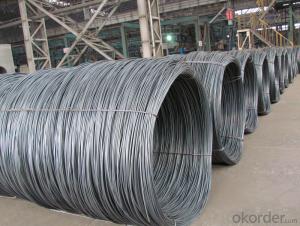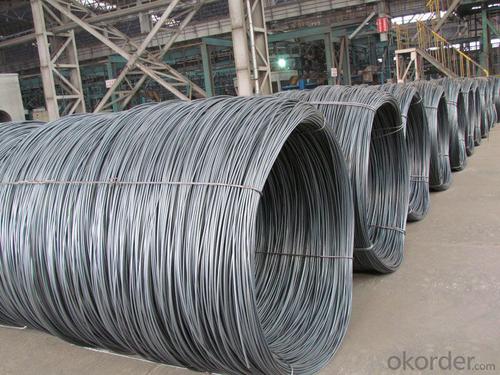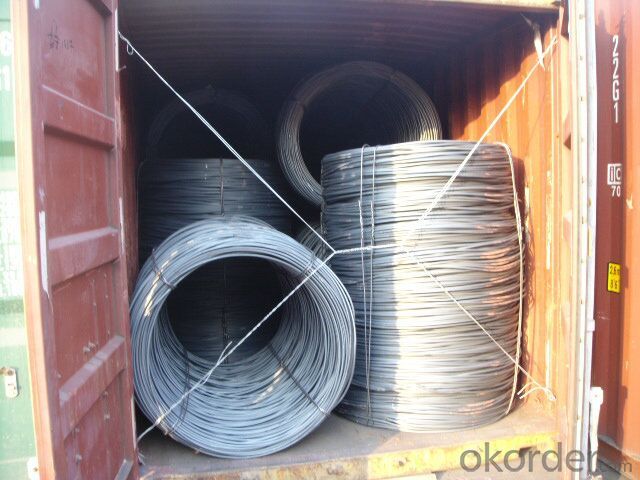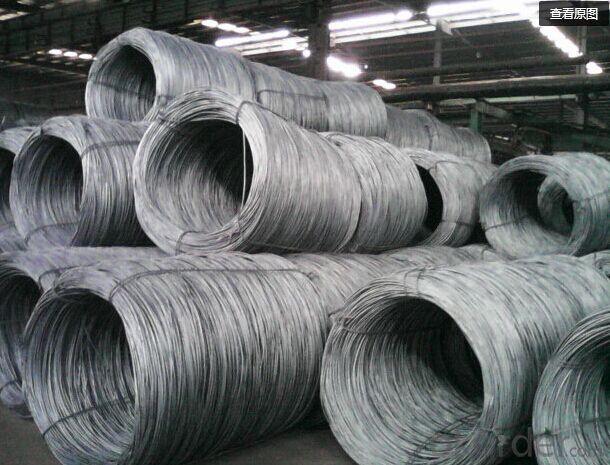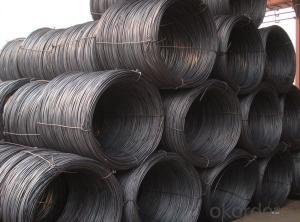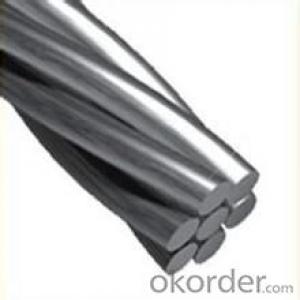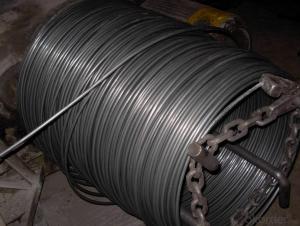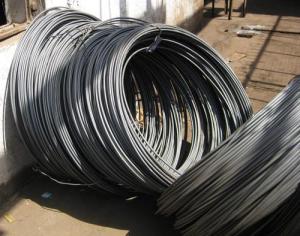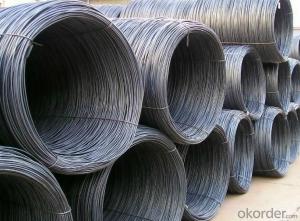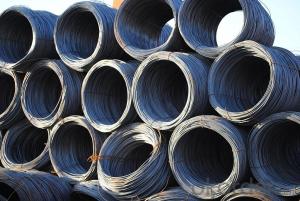Structure Steel Rod SAE1008B Steel Rod in Coils
- Loading Port:
- Tianjin
- Payment Terms:
- TT OR LC
- Min Order Qty:
- 30 m.t.
- Supply Capability:
- 20000 m.t./month
OKorder Service Pledge
OKorder Financial Service
You Might Also Like
Specification
Usage and Applications for Structure Steel Rod SAE1008B Steel Rod in Coils
The products are widely used in construction and manufacturing, mainly for reinforcement of reinforced concrete and
welded structure or reprocessed (roberts , nail, etc.) materials, especially used to produce wire drawing, welding
electrode, nails, spring, electronic, precise machinery parts and so on.
Specification for Structure Steel Rod SAE1008B Steel Rod in Coils
Steel Grade: Q195/235, SAE1006-1018B
Standard: ASTM, GB
Diameter: 5.5mm, 6.5mm, 7mm,8mm,9mm,10mm,12mm,14mm
Type: in coil, coil weight around 2MT
Alloy or Not: Alloy
Technique: Hot Rolled
Place of Origin: China Mainland
Surface: round, no twisted, light and smooth
Chemical Composition for Structure Steel Rod SAE1008B Steel Rod in Coils
Grade | Chemical Composition(%) | |||||
C | Mn | Si | S | P | B | |
SAE1006B | 0.03~O.07 | ≤0.32 | ≤0.30 | ≤0.045 | ≤0.040 | >0.0008 |
Mechanical properties | ||||||
Yield strength(N/mm2) | Tensile strength(N/mm2) | Elongation(%) | ||||
250-280 | 350-380 | ≥32 | ||||
Packaging and delivery for Structure Steel Rod SAE1008B Steel Rod in Coils
Packaging Detail: products are packed in coil, each coil weight around 2 MT, and then shipped by container or bulk vessel
Delivery Detail: within 45 days after received deposit or LC.
Label: to be specified by customer, generally, each bundle has 1-2 labels
Images for Structure Steel Rod SAE1008B Steel Rod in Coils

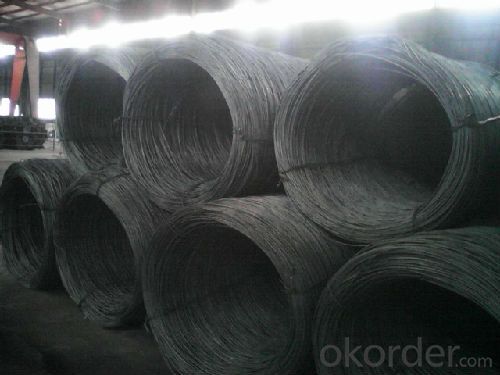
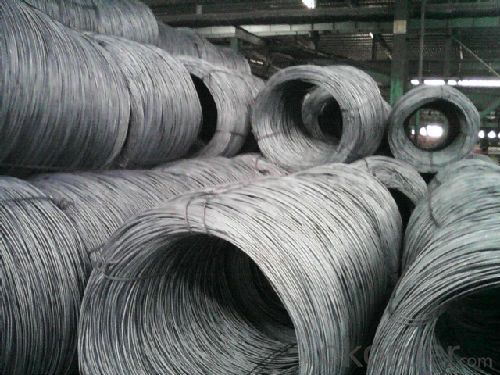
FAQ:
Q1: Why buy Materials & Equipment from OKorder.com?
A1: All products offered byOKorder.com are carefully selected from China's most reliable manufacturing enterprises. Through its ISO certifications, OKorder.com adheres to the highest standards and a commitment to supply chain safety and customer satisfaction.
Q2: How do we guarantee the quality of our products?
A2: We have established an advanced quality management system which conducts strict quality tests at every step, from raw materials to the final product. At the same time, we provide extensive follow-up service assurances as required.
Q3: How soon can we receive the product after purchase?
A3: Within three days of placing an order, we will begin production. The specific shipping date is dependent upon international and government factors, but is typically 7 to 10 workdays.
- Q: What are the trends in the steel wire rod market?
- The trends in the steel wire rod market include increased demand due to infrastructure development, automotive industry growth, and the rising popularity of steel wire rods in construction and manufacturing sectors. Additionally, there is a shift towards the production of high-quality and technologically advanced steel wire rods, as well as a focus on sustainability and environmental regulations.
- Q: How are steel wire rods used in the production of wire coat hangers for hanging clothes?
- The durability and strength of steel wire rods make them essential for producing wire coat hangers used to hang clothes. These rods are the primary material for creating the frame and shape of the hangers. To begin, the steel wire rods are cut into the desired length for the coat hangers, ensuring the appropriate size for hanging clothes. Specialized machinery is then used to bend and shape the rods into the classic triangular form commonly associated with coat hangers. Next, the ends of the wire rods are smoothed and rounded off to prevent any sharp edges that could potentially damage clothing. This step is crucial for ensuring the safety of the hangers and avoiding harm to the garments being hung. Once the wire rods have been shaped and smoothed, they undergo a protective coating process, typically using plastic or rubber. This coating serves multiple purposes. Firstly, it prevents rusting or corrosion, ensuring the longevity of the hangers. Additionally, it provides a non-slip surface that helps prevent clothes from slipping off. Finally, the coated wire rods are securely attached to a separate hook at the top, allowing the hangers to be hung on a closet rod or any suitable hanging mechanism. This hook is usually made of either plastic or metal and ensures the stability and functionality of the coat hanger. Overall, steel wire rods are vital in the production of wire coat hangers, providing the necessary strength, durability, and shape for hanging clothes. Their versatility and ability to be shaped and coated make them an ideal material for creating reliable and long-lasting hangers.
- Q: What is the standard length of steel wire rod?
- The standard length of steel wire rod can vary depending on the specific industry and application. Generally, steel wire rods are produced in lengths ranging from 5.5 meters to 12 meters. However, it is important to note that customized lengths can also be produced according to the requirements of the customer. The length of the steel wire rod is determined by factors such as the intended use, manufacturing process, and transportation logistics.
- Q: How are steel wire rods used in the manufacturing of wire brushes for cleaning surfaces?
- Steel wire rods are an integral component in the manufacturing of wire brushes used for cleaning surfaces. These rods are typically made from high-quality steel, which ensures durability and longevity of the wire brushes. The manufacturing process begins with the selection of the appropriate steel wire rod, which is then cut into small sections of the desired length. These sections are straightened and then fed into a machine where they undergo a series of processes to transform them into the bristles of the wire brush. Once the wire rod sections are fed into the machine, they are first twisted together to form a bundle, creating a dense cluster of bristles. This twisting process ensures that the bristles are tightly secured together, preventing them from coming loose during use. The twisted wire bundle is then inserted into a metal ferrule, which serves as the handle of the wire brush. The ferrule is crimped or soldered onto the twisted bundle to securely attach it to the handle, ensuring the brush remains intact during heavy-duty cleaning. After the bristles are securely attached, the wire brush undergoes further manufacturing processes to give it its final shape and functionality. This may include trimming the bristles to a specific length, shaping them into a flat or angled profile, or even attaching additional features such as scraper blades or abrasive pads. Steel wire rods used in the manufacturing of wire brushes offer several advantages. The high tensile strength of steel ensures that the bristles maintain their shape and stiffness, allowing for effective and efficient cleaning. Steel wire rods are also resistant to wear and corrosion, making them ideal for use in demanding cleaning applications. In conclusion, steel wire rods play a crucial role in the manufacturing of wire brushes for cleaning surfaces. They provide the necessary strength, durability, and flexibility required for effective cleaning, ensuring that wire brushes are capable of removing dirt, grime, and debris from a variety of surfaces.
- Q: What are the different types of steel wire rod finishes for improved impact resistance?
- There are several types of steel wire rod finishes that can improve impact resistance. Some common finishes include galvanized, epoxy coated, and zinc-coated finishes. These finishes provide a protective layer that enhances the durability and strength of the wire rod, making it more resistant to impacts and potential damage.
- Q: What are the advantages of using galvanized steel wire rod?
- Galvanized steel wire rod offers numerous benefits. Firstly, its zinc coating ensures a high level of corrosion resistance, making it ideal for outdoor use in moist and harsh weather conditions. Secondly, this type of wire rod is exceptionally durable, thanks to the added layer of protection provided by the zinc coating. Consequently, it can withstand heavy loads without breaking or deforming. Its durability makes it perfect for demanding applications such as construction and fencing. Furthermore, galvanized steel wire rod is highly versatile, easily adaptable to different applications. It can be bent, twisted, and cut to meet various industry needs, including agriculture, automotive, and manufacturing. This versatility allows for the creation of products like fences, wire mesh, and springs. Additionally, galvanized steel wire rod proves to be cost-effective in the long run. Although the initial galvanization process may require a higher investment than other steel types, its corrosion resistance and durability minimize maintenance requirements and extend its lifespan. Consequently, the need for frequent replacements is reduced. Lastly, galvanized steel wire rod is environmentally friendly. The non-toxic and recyclable nature of the zinc coating used in the galvanizing process ensures that the wire rod can be easily recycled at the end of its lifespan, thereby reducing waste and minimizing its environmental impact. In conclusion, the advantages of galvanized steel wire rod encompass its high corrosion resistance, durability, versatility, cost-effectiveness, and environmental friendliness. These qualities make it the preferred choice for a wide range of applications in various industries.
- Q: What are the dimensions of steel wire rod?
- The dimensions of steel wire rod can vary depending on the specific requirements and applications, but common dimensions range from 5.5mm to 14mm in diameter.
- Q: What are the different surface finishing techniques for steel wire rod?
- Some of the different surface finishing techniques for steel wire rod include galvanizing, electroplating, phosphating, and powder coating.
- Q: What are the different shapes of steel wire rod?
- Steel wire rods are available in a variety of shapes and sizes, each with its own specific properties and applications. Here are some common shapes: 1. Round wire rods: This shape is widely used for general purposes like fencing, construction, and manufacturing various products. Round wire rods offer great strength and versatility. 2. Square wire rods: With four equal sides, these rods provide additional strength and stability. They are commonly used in applications such as manufacturing springs, fasteners, and electrical wiring. 3. Flat wire rods: Featuring a rectangular cross-section, flat rods are suitable for applications that require a wide but thin surface area. They find use in the manufacturing of automotive parts, furniture, and conveyor belts. 4. Hexagonal wire rods: These rods have six sides and are ideal for applications that require a higher grip or torque. They are commonly used in the manufacturing of nuts, bolts, and mechanical components. 5. Deformed wire rods: Deformed rods have ridges or deformations on their surface, enhancing their bonding properties. They are suitable for reinforcement purposes, such as in the production of reinforcing bars (rebars) used in construction projects. These examples represent only a few of the available shapes of steel wire rods. The choice of shape depends on specific application requirements, including strength, stability, grip, and bonding properties.
- Q: What are the common applications of galvanized and oil tempered steel wire rod?
- Due to its protective zinc coating, galvanized steel wire rod finds wide application in various fields. The galvanization process involves applying a layer of zinc to the surface of the steel wire rod, which offers excellent resistance against corrosion. This makes galvanized steel wire rod the ideal choice for situations where the material will be exposed to moisture, chemicals, or harsh environments. Some common uses of galvanized steel wire rod include: 1. Fencing and wire mesh: Galvanized steel wire rod is extensively utilized in the construction of fences and wire mesh. The zinc coating helps to prevent rust and corrosion, ensuring the long-lasting and durable nature of the fencing or mesh. 2. Construction: Galvanized steel wire rod is employed in numerous construction applications, such as reinforcing concrete. The added strength and corrosion resistance of galvanized steel make it an excellent option for reinforcing structures and providing stability. 3. Automotive industry: Galvanized steel wire rod is used in the manufacture of automotive parts and components. It is often employed in the production of springs, suspension systems, and wire harnesses due to its high strength and resistance to corrosion. 4. Electrical applications: Galvanized steel wire rod is commonly used in electrical applications, including cable armor and grounding wires. The zinc coating provides an extra layer of protection against corrosion, ensuring the safety and reliability of electrical systems. On the other hand, oil tempered steel wire rod is a high-strength material that undergoes heat and oil treatment to improve its mechanical properties. This process involves heating the steel wire rod to a specific temperature and then quenching it in oil. The result is a wire rod with enhanced toughness, durability, and resistance to fatigue. Some common uses of oil tempered steel wire rod include: 1. Springs: Oil tempered steel wire rod is widely employed in the production of springs, such as coil springs, suspension springs, and valve springs. The high strength and excellent fatigue resistance of oil tempered steel make it ideal for applications that require reliable and long-lasting springs. 2. Mechanical components: Oil tempered steel wire rod is used in the manufacture of various mechanical components, including shafts, gears, and fasteners. Its high strength and toughness make it suitable for applications where durability and reliability are crucial. 3. Automotive industry: Oil tempered steel wire rod is extensively utilized in the automotive industry for applications such as seat frames, seat belts, and suspension systems. The superior mechanical properties of oil tempered steel ensure the safety and performance of automotive components. 4. Industrial equipment: Oil tempered steel wire rod is employed in a wide range of industrial equipment, such as conveyor belts, wire ropes, and crane cables. Its high tensile strength and resistance to fatigue make it an ideal material for handling heavy loads and enduring demanding conditions. In conclusion, both galvanized and oil tempered steel wire rods have their unique applications and advantages. Galvanized steel is primarily selected for its corrosion resistance, while oil tempered steel is chosen for its high strength and durability.
Send your message to us
Structure Steel Rod SAE1008B Steel Rod in Coils
- Loading Port:
- Tianjin
- Payment Terms:
- TT OR LC
- Min Order Qty:
- 30 m.t.
- Supply Capability:
- 20000 m.t./month
OKorder Service Pledge
OKorder Financial Service
Similar products
Hot products
Hot Searches
Related keywords
